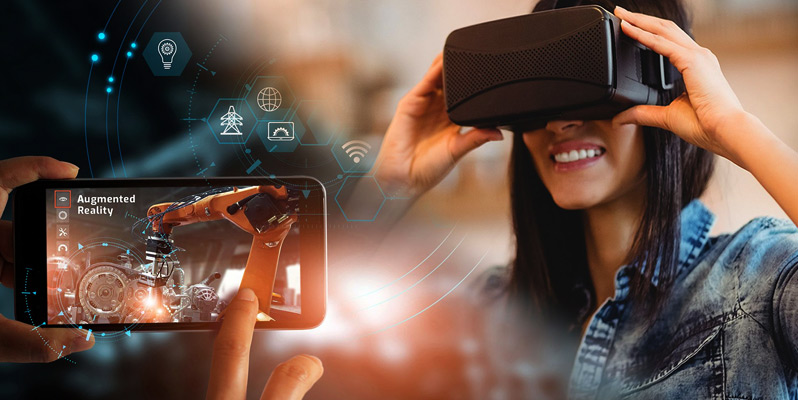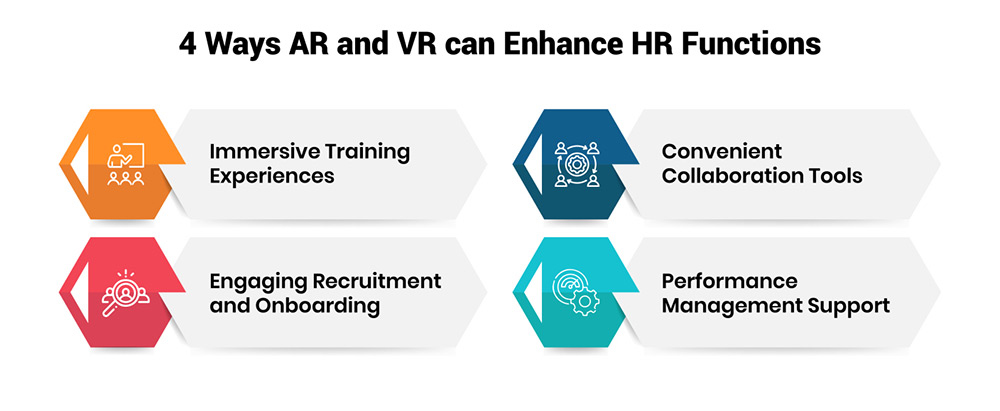How Augmented Reality and Virtual Reality are Transforming the Future of HR
September 10, 2024

Augmented reality (AR) and virtual reality (VR) are emerging technologies that offer immense potential for transforming the way human resource (HR) functions are carried out in organizations. These immersive technologies can revolutionize various HR processes like recruitment, onboarding, training, performance management, and employee engagement.
Let us explore how HR departments can take advantage of AR and VR technologies to their fullest potential and deliver enhanced experiences for both employees and job seekers.
Importance of Innovation in Human Resources
For HR departments to effectively support their companies' evolving needs, innovation must be a key priority. Outdated and inefficient HR processes can negatively impact employee experience, talent acquisition and retention. By embracing new technologies and ideas, HR can transform workflows and the overall employee journey.
-
Changing Talent Landscape
The current talent landscape is changing rapidly due to various factors like an aging population, skills gaps, and changing workforce demographics. To attract and engage the future workforce, HR needs innovative strategies. Static HR systems will struggle to connect with new generations of candidates who grew up with technology. Innovation allows HR to develop engaging, personalized experiences that cater to a diverse range of talent needs and preferences.
-
Improving Operational Efficiency
Manual, paper-based HR functions are time-consuming and prone to errors. Innovative technologies like robotic process automation (RPA) can streamline repetitive tasks and improve accuracy. Data analytics solutions provide useful insights to optimize processes. Cloud-based HRIS platforms promote flexible, remote working. All these innovations help HR teams work smarter with limited resources. The productivity gains translate to better support for strategic objectives.
-
Fostering Organizational Growth
Innovation in HR fuels organizational growth in multiple ways. A tech-savvy employer brand attracts top talent. Personalized learning and development opportunities boost employee skills and performance. Data-driven insights help make strategic decisions. New ideas in areas like diversity and inclusion create inclusive, vibrant workplaces where people can excel. All this strengthens the organization's capacity for expansion, innovation and long-term success.
Purpose of Integrating AR and VR in HR Functions
Emerging technologies like augmented reality (AR) and virtual reality (VR) offer exciting opportunities to innovate key HR functions and improve the employee experience. Some ways AR and VR could enhance HR management are:

-
Immersive Training Experiences
Training is crucial but traditional methods lack engagement. VR simulations recreate real work environments for hands-on learning safely. Complex processes and expensive equipment can be demonstrated virtually. AR overlays just-in-time guidance on physical tasks. Such immersive learning boosts knowledge retention.
-
Engaging Recruitment and Onboarding
Candidates get meaningful insights into roles and culture through VR. AR chats make connections personal. VR orientates new hires to their surroundings without disrupting current teams. This strategic use of AR/VR facilitates recruitment and smoother onboarding.
-
Convenient Collaboration Tools
Distributed teams effectively collaborate in virtual spaces through VR conferences. AR enhances remote support through virtual annotations. Both technologies alleviate constraints of physical distance for workgroups.
-
Performance Management Support
Managers conduct AR-assisted walkthroughs to provide real-time feedback. VR simulations evaluate soft skills under realistic pressures. Together, AR and VR strengthen performance management frameworks.
To summarize, innovations like AR and VR empower HR with interactive, engaging solutions that boost key functions from training to recruitment. Integrating such immersive technologies nurtures talent and streamlines operations for sustainable organizational success.
How HR Departments Can Utilize AR and VR Technologies
Here is how HR departments can take advantage of AR and VR technologies:
-
Revolutionizing Recruitment and Onboarding
AR and VR provide innovative ways for organizations to streamline their recruitment and onboarding processes. Virtual interviews and assessments facilitated through VR allow candidates to engage in interactive scenarios from anywhere in the world. This dynamic approach helps hiring managers evaluate skills and fit better than traditional interviews. Job applicants also find it more engaging.
VR offers virtual office tours for prospective employees. Those unable to visit the workplace in person gain valuable insights into company culture and work environment through these virtual tours. This fosters a stronger employer brand and improves hiring outcomes.
For onboarding new hires, AR and VR create opportunities for interactive orientation programs. New employees can participate in virtual sessions to familiarize themselves with company policies, systems and teammates. With AR experiences overlaying informative layers onto physical spaces and assets, they learn about facilities at their own pace. Such immersive onboarding helps new recruits integrate faster while building higher motivation and satisfaction levels.
Overall, recruitment and onboarding powered by AR and VR help organizations attract and retain top talent in a cost-effective way. Job seekers find these technology-led experiences more exciting than traditional methods. They gain realistic previews to determine career fitment faster. Meanwhile, companies optimize resources spent on these critical HR functions.
-
Enhancing Training and Development
AR and VR-embedded simulations allow safe, risk-free practice of real-world job scenarios for effective training. Industries like manufacturing, aviation and healthcare leverage VR to train employees in complex and sensitive operations without any danger. Learners gain familiarity with processes, catch mistakes and improve performance without consequences - a vital capability for roles involving expensive equipment or human safety.
During maintenance tasks involving heavy machinery or hazardous materials, simulated VR training empowers workers to refresh skills regularly at lower costs than physical refresher courses. Companies achieve ongoing compliance and eliminate risks of accidents through such immersive learning modes.
For theoretical topics, AR enhances comprehension by overlaying supplementary information contextually onto physical materials, products or work areas. Trainees access detailed guidelines, part diagrams, safety protocols or troubleshooting steps conveniently through augmented displays. This makes dry subjects come alive and boosts retention of learning points.
Emerging AR capabilities are also enabling remote training capabilities and consistency across geographies. VR sessions allow globally dispersed teams of any size to come together visually and receive coaching or refresher briefs from subject matter experts through interactive virtual classrooms regardless of their physical locations. This slashes time and expenses related to travel while widening access to training for all.
-
Improving Collaboration and Soft Skills
Building human connections is critical for employee engagement, retention and performance. AR and VR help address this vital aspect, overcoming barriers like remote work setups or lack of in-person interactions.
Collaborative virtual environments powered by VR foster deeper teamwork through scenarios simulating real conditions. Teams bonded over shared virtual experiences feel higher satisfaction from remote employment. Managers also gain from observing subordinates apply soft skills in virtual situations for fair evaluation and development.
AR and VR further nurture inclusion through universal accessibility features. Virtual workspaces become barrier-free for colleagues with disabilities, supporting the needs of all. Diversity and cultural simulations spread through virtual classrooms assist in sensitization at scale.
Innovations like virtual team rooms and interactive visual displays foster synergized project work across distances through AR integration on devices. This pushes engagement indicators upwards.
Mental well-being finds address via VR-enabled activities simulating nature, meditation, physical exercises and socialization - important for long-term remote personnel retention. Such initiatives fortify employer value propositions.
-
Optimizing Performance Management
Performance reviews and feedback receive upgrades through AR and VR for more objectivity and action plans. Managers leverage immersive virtual sessions to discuss achievements and areas of improvement with geographically separated reports, strengthening rapport throughout assessments.
Metrics, KPIs and analytics visualizing past-current-future work trends augment reviews for fact-based discussions on unique challenges, customized to facilitate actionable guidance. Teams learn from past mistakes in VR simulations for continuous excellence.
Remote observation, AR-based on-field feedback and validation of skills become practical. Fair, frequent and structured performance conversations keep professionals focused to deliver peak outputs, feel heard and retain high morale over distance.
-
Centralizing HR Processes with AR and VR
AR/VR-powered centralized platforms enable end-to-end automation of HR operations with minimal errors. Seamless workflows across modules save time spent on redundant tasks.
Analytics-backed dashboards grant management, and real-time insights into metrics like retention, productivity, hiring costs and other opportunities for strategic decision-making. Automated tasks further simplify compliance management.
Intuitive UX across the web and smart glasses increase user-friendliness. Gamified simulations and virtual assistance resolve queries swiftly. Customizable portals tailor the experience as per profiles - motivating performance.
Geo-location and IoT-enabled AR facilities like virtual helpdesk, instant support tickets, presence management and device integration streamline daily operations globally. Robotics Process Automation minimizes manual workflows.
Conclusion
In conclusion, HR professionals must seize opportunities presented by digital innovations to reinforce employee experience, spark higher contributions and optimize processes throughout the organizational talent cycle. Mainstreaming AR and VR can redefine traditional HR functions by engaging workers creatively at each touchpoint while boosting operational efficiencies manyfold.
With continuous technological expansions, the full potential of immersive experiences for talent management still remains untouched. Organizations willing to experiment with new realities will gain competitive differentiation in the evolving marketplace and workforce dynamics.

